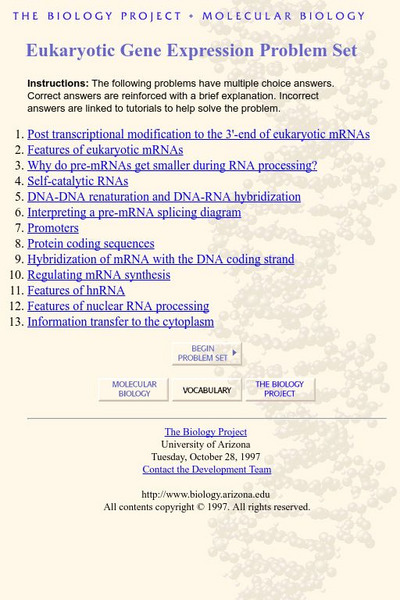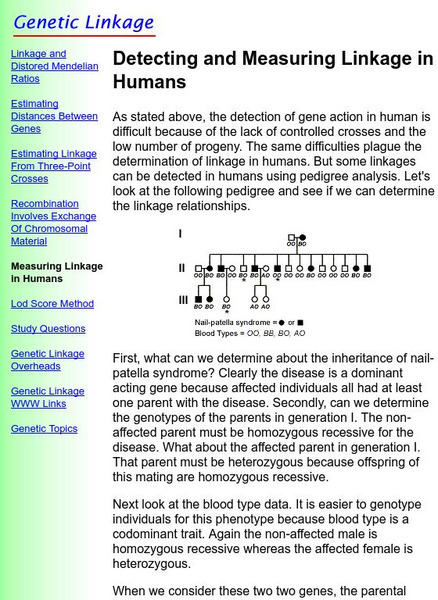Hi, what do you want to do?
Curated OER
Who Owns Rights to Pharmacogenetic Information?
Pupils develop an understanding of the rationale of ownership over scientific information. They research commercial applications of DNA sequences. They analyze how to evaluate medical ethics issues.
Curated OER
Disproving the Proof
Students investigate the progression of discoveries that have led to the genetics knowledge that scientists currently have. They determine how genetic experiments disproved previous theories on inheritance.
What2Learn
What2 Learn: Gene Trivia
This Science game about genes was created using the What2Learn game machine. The objective of the game is to correctly answer the questions about genetics. Students should learn genetics and heredity before playing the game.
Oklahoma State University
Oklahoma State University: Ag in the Classroom: Hairy Heredity [Pdf]
A simulation where students flip coins to mimic how parents pass genetic traits to their offspring through heredity. This activity also illustrates the difference between dominant and recessive genes, and how they interact with each...
Curated OER
Kids Health: The Basics on Genes and Genetic Disorders
Genes can sometimes be a difficult topic for students to understand, but this article provides a nice description of genes, how they work, and the disorders that can sometimes arise. The article also touches on how genetic engineering...
University of Utah
University of Utah: Genetic Science Learning Center: Heredity and Traits
The Genetic Science Learning Center presents the world of heredity and traits including activities to better comprehend the science, clear explanations of aspects of heredity, and an interactive opportunity.
Nobel Media AB
The Nobel Prize: Thomas Hunt Morgan and His Legacy
This detailed article from the Nobel e-Museum explores Thomas Hunt Morgan's career and research in genetics. Read how Morgan's work influenced later scientists and the modern scientific world.
University of Hamburg
University of Hamburg: Deviations From Mendelian Laws And: What Is the Meaning of Dominance?
Upper level discussion of several of Mendel's experiments and laws.
Cold Spring Harbor Laboratory
Dolan Dna Learning Center: Learn About Genetics: Genes & Inheritance
An animation introducing the basic concepts of cells, DNA, recessive inheritance, and Punnett squares.
Vision Learning
Visionlearning: Genetics: Gene Expression
Explore the connection of genes and enzymes in regards to heredity and genetics. Concepts associated with dominant and recessive traits are also presented.
National Institutes of Health
Niehs: Kids' Pages: You and Your Genes
Online children's story that teaches about genes and how they direct how you react to things in your environment. Click on "next" at the bottom of the story to see how different people respond differently to harmful substances.
PBS
Pbs Learning Media: Animal Body Plans: Homeobox Genes
The homeobox genes that define the basic body plan of mice and fruit flies are illustrated in this graphic from The Human Evolution Coloring Book by Adrienne Zihlman. The accompanying article describes how these genes act as "molecular...
Cold Spring Harbor Laboratory
Dna From the Beginning: Genes Are Real Things
Long after Gregor Mendel knew that something controlled heredity three other scientists finally put his research together with new evidence from microscopes to determine that genes do exist. This multimedia article includes animations,...
University of Arizona
The Biology Project: Immunology: Eukaryotic Gene Expression Problem Set
Students have the opportunity to work through a problem set over Eukaryotic genes. Correct answers are reinforced with a brief explanation. Incorrect answers are linked to tutorials to help solve the problem.
University of Utah
University of Utah: Learning Center: learn.genetics: Nutrition and the Epigenome
Read about how environmental factors such as nutrition can change a person's gene expression.
BioEd Online
Bio Ed Online: Reebops: A "Model" Organism for Teaching Genetic Concepts
In this lesson students create imaginary creatures, called "Reebops," to explore the relationships between genes and inherited traits. Using Reebops as a model, students learn how hereditary information is passed from one generation to...
CommonLit
Common Lit: "Don't Hate on the Trait" by Bird Brain Science
CommonLit.org is a wonderful resource to use in a Language Arts classroom. Each story or article is accompanied by guided reading questions, assessment questions, and discussion questions. In addition, students can click on words to see...
University of Utah
University of Utah: learn.genetics: Ptc: The Genetics of Bitter Taste
Read about the PTC gene, and listen to scientists discuss this accidental discovery which lead to important clues about human evolution.
Nobel Media AB
The Nobel Prize: The Nobel Prize in Physiology or Medicine 1933
At this site from The Nobel Foundation you can read about Thomas Hunt Morgan, the scientist who won the Nobel Prize in Medicine "for his discoveries concerning the role played by the chromosome in heredity." This website is organized...
University of Utah
University of Utah: learn.genetics: Finding a Gene on the Chromosome Map
Play the role of a scientist and piece together the genetic puzzle to determine the gene responsible for a disorder.
Other
North Dakota State Univ.: Detecting and Measuring Linkage
A good site to establish what is meant by gene linkage and sex-linkage.
Soft Schools
Soft Schools: Mendelian and Molecular Genetics Quiz
Take this interactive quiz over Mendelian and molecular genetics, then review your score and any missed questions at the end.
McGraw Hill
Glencoe Biology: Genetics and Biotechnology: Chapter Test Practice
Fifteen multiple choice review questions over genetics and biotechnology. After the quiz, the self-checking feature allows students to see which were the correct answers.
TeachEngineering
Teach Engineering: Heredity Mix 'N Match
This site includes a lesson plan designed to teach students how genetic traits are passed down from parents to offspring. Students will explore such concepts as random selection, chrosomes, genotypes and phenotypes using jelly beans and...























